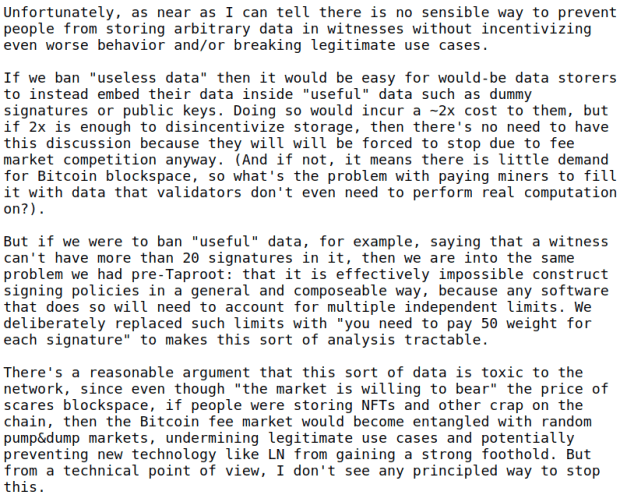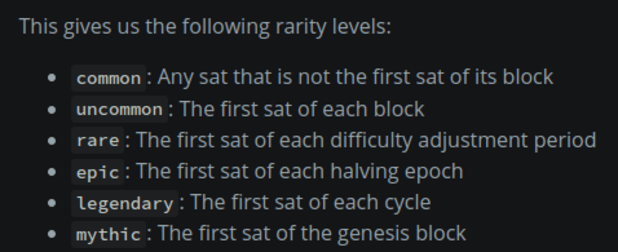The surge of inscriptions raises old debates about Bitcoin’s “true” purpose and its ability to become the money of the internet.
This is an opinion editorial by Stephan Livera, host of the “Stephan Livera Podcast” and managing director of Swan Bitcoin International.
So, we’ve recently seen a Bitcoin transaction take up nearly an entire block and default mempools (300 MB) get filled up. What’s going on with all this Ordinals and inscriptions madness?
The Quick Explainer
Ordinals are a made up way of tracking sats (a fraction of a bitcoin) across transactions. Now, I stress it is a made up way of tracking sats, as it does not meaningfully impact bitcoin’s fungibility. As explained by creator Casey Rodarmor on my podcast, it’s a convention of numbering sats in the order they’re mined into existence, and tracking them across transactions in a first in, first out (FIFO) method. So, as Bitcoin transactions are made up of inputs and outputs, the first satoshi in the first input is considered to be transferred to the first output of a transaction. There are conventions around which Ordinals are uncommon, rare, epic, etc.
What’s An Inscription?
An inscription is another made-up convention where sats can be inscribed with arbitrary content, a kind of Bitcoin-native digital artifact or NFT. Using the convention, they can be sent around and stored in a Bitcoin unspent transaction output (UTXO). Now, because they are coded in such a way that they are written into transaction witnesses, they never enter the UTXO set. The UTXO set is seen as having heightened consideration for the network because every node (even pruned nodes) must maintain this UTXO set. So, I guess it could have been worse…
What’s The Bull Case For Ordinals And Inscriptions?
To steel man the case a little: The pro Ordinals and inscriptions case could broadly be understood as: “Come for the fun, rich art, stay for the decentralized digital money.”
You could also agree with some of the critiques of shitcoin NFTs, and see this as a way of arguing that “Bitcoin does it better” e.g., Bitcoin inscriptions are immutable, always on chain, simpler and more secure than shitcoin NFTs.
Concerns Raised With Inscriptions
The main concerns here are:
- Reduced accessibility to transact on Bitcoin because of inscription/NFT degens creating a transaction backlog and paying a lower fee per real byte because of the witness discount
- Reduced ability for users to run a full Bitcoin node because of the increased storage and bandwidth requirements
- The possibility of illegal material being recorded into Bitcoin’s blockchain that might discourage some users from running a Bitcoin node
Of course, there are counter arguments also:
- Bitcoin was eventually going to develop a fee/blockspace market anyway and this may help with long-term viability of the network. Inscriptions may just form a “low value backlog” of transactions.
- Bandwidth and storage costs have come down over the years since 2017. Though, arguably, bandwidth over Tor may still be problematic for those syncing a full node in a more private fashion. It could also be argued that it’s all still within conservative design limits that the network effectively accepted in 2017.
- Illegal material on chain was always possible because you can’t fully stop steganography on bitcoin. Steganography is when you represent information within another message, in such a manner that the presence of the information is not evident to normal human inspection.
Revisiting Old Debates In Bitcoin: Purpose, Scaling And More
Some are arguing that, “We shouldn’t have raised the block size with SegWit and the witness discount in 2017” and, to some extent, this latest Ordinals and inscriptions trend is raising similar questions as those in the OP_RETURN wars of 2014.
What is Bitcoin for? And should arbitrary data that doesn’t relate to financial transactions be encouraged or discouraged on Bitcoin’s blockchain?
Taproot Is Not To Blame
Some commenters were initially blaming the Taproot soft fork for inscriptions. But Taproot seems to only save about 4% on the cost of inscriptions.
It’s also worthwhile to note that this kind of thing was possible with SegWit, and beforehand with OP_RETURN and even before that, with fake signatures, as explained by Adam Back here:
Cultural Issues
Some ETH huffers and cRyPtO people are enjoying this moment because, in their eyes, they can “stick it to the maxis” and those of a more “Bitcoin fundamentalist” persuasion, i.e., the people who believe bitcoin should be a money.
I’m closer to the “fundamentalist” camp myself, seeing my mission as being about advancing bitcoin as money. And surely, after all the effort of Bitcoin developers to optimize and use blockspace more efficiently, the inscriptions on chain seem wasteful and unnecessarily decreasing Bitcoin’s accessibility for use in financial transactions.
Some argue that taking actions against Bitcoin inscriptions is “censorship” and that it’s wrong to view these transactions as “spam,” given that they pay a bitcoin transaction fee. But in the end, it comes to the purpose of the project. While yes, it’s true that Bitcoin is designed to be censorship resistant and that NFTs arguably “started on Bitcoin” in years gone by, Bitcoin is arguably meant to be more about decentralized and peer-to-peer electronic cash.
Can This Trend Realistically Be Stopped?
Short of drastic action, probably not. At least, that’s what Andrew Poelstra spelled out in a recent post on the bitcoin-dev mailing list:

It’s also the wrong play to be too reactive about inscriptions and to try to take some drastic action to soft fork or make inscriptions unviable at a technical level. There are arguably bigger fish to fry, like helping improve Bitcoin adoption as money and helping encourage further decentralization in the custody of bitcoin, the mining of bitcoin, the scalability and verifiability of Bitcoin, etc.
Ossification? Not Yet
Some even go so far as to argue that, “Oh, this is a mistake and we must ossify the Bitcoin protocol now to stop any further mistakes.” I think this would also be an error. There are various soft fork ideas that are opt in, do not harm non users and could help scale bitcoin self custody. For example, ANYPREVOUT or OP_VAULT.
ANYPREVOUT in particular is interesting to me because someday, with global adoption, we may have approximately 80,000 times the transactional demand that we have now. In that world, ANYPREVOUT enables an upgrade to “Eltoo” Lightning, giving us a way to share the cost of on-chain transactions in a self-custodial way. If we want Bitcoin to be used in a way that’s more self sovereign, we ideally want people to be able to afford to take self custody on chain. Without this, they may be confined into custodial platforms because the cost of self custody is too prohibitive. Eltoo also has various benefits for Lightning, such as making backups easier.
Yes, we should be conservative, but we should also consider technologies that help bitcoin be the best that it can be at being digital hard money.
Bottom Line
While I’m “against” inscriptions in a sense and would rather they be socially discouraged, I also don’t think it’s worth getting too worried about them for now. For all we know, they could be a short-lived fad.
But even if they are not a short-lived fad, what’s the most likely outcome here? Low-value inscriptions will likely be priced out by financial transactions over time as Bitcoin gets adopted by more people. It’s just that adoption happens in a “lumpy” way and it’s concentrated into periods of high use (as seen in 2013, 2017 and 2021), and then periods of relative doldrums as transaction volume subsides, and new technology and scaling techniques are applied.
Over the medium to long terms, financial transactions will come to dominate in Bitcoin. Other uses of Bitcoin will be subordinate to its use as decentralized money for the internet.
This is a guest post by Stephan Livera. Opinions expressed are entirely their own and do not necessarily reflect those of BTC Inc or Bitcoin Magazine.
Credit: Source link
































